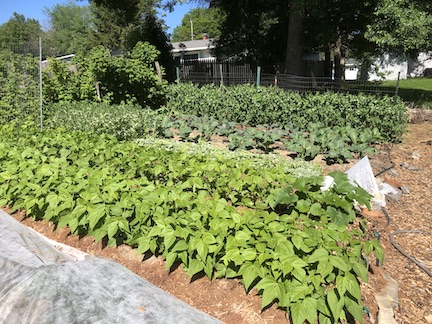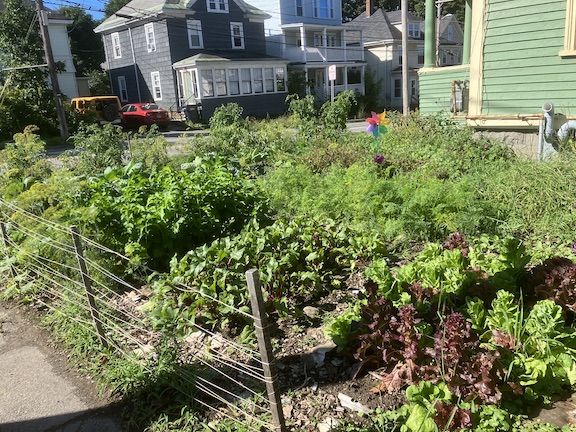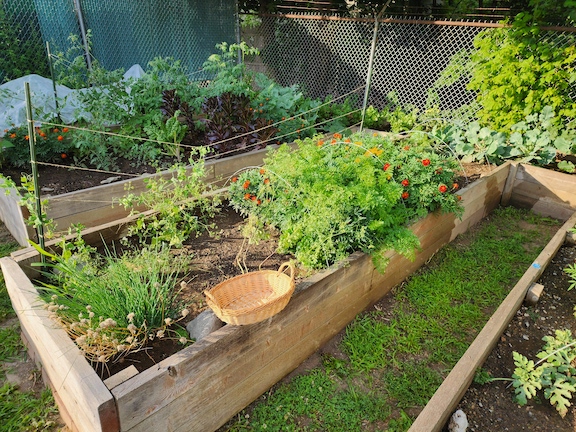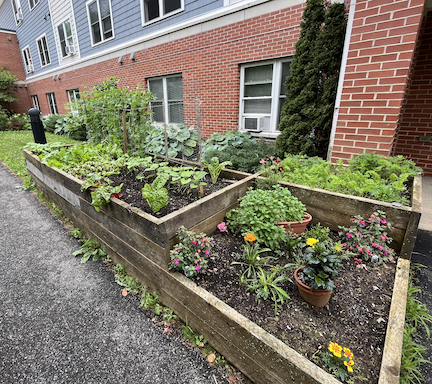
By Larry Dansinger
The gathering crisis of the Earth’s warming climate is a wild card like no other. Everything humans have thought and understood about our environment, especially how to grow enough food for billions on this planet, is being questioned. As the weather and growing conditions become more unpredictable, with heavy rains, droughts, extreme heat, new plant diseases, and habitat loss, it makes sense to explore many options to insure food security for our world. For humans to survive into the future means a recalibration of almost everything we thought we knew about food production.
Fewer farmers are growing more of the food we all consume, and that is tenuous. What we need is more people growing food for themselves and each other.
Since moving to Bangor from rural Maine in 2015, my partner Karen and I have continued to garden in our large backyard, trying to produce most of a year’s supply of vegetables and fruits. But, we are the exception. Most residents have little more than a lawn they mow with a gas-powered machine, usually reluctantly and occasionally obsessively. You might see a few flowers or an occasional tomato plant. Cities are not yet a hotbed of gardening passion. Such a waste of fertile ground!
In my review of “A Small Farm Future” (available on MOFGA’s website), I talked about author Chris Smaje’s proposal that many urban dwellers will move to rural areas to grow more food and increase food security. I don’t think this is logistically likely given that more people are moving from rural to urban areas. A blossoming of urban gardening, “greening the city,” seems much more likely than moving to a new, rural location. More gardens and local food will support the local (agricultural) economy, too.
Lawns are not a “highest and best” use for the soil. A frequently mowed lawn may take less time than a garden but not a perfectly manicured one. Environmentally, vegetables, herbs, flowers and fruit trees/bushes keep the city cooler in summer. Organic gardens reduce greenhouse gases and eliminate some fossil fuel use. They require less water than watering a lawn. They reduce transportation costs in getting food to consumers. They feed the insects that are disappearing.
There are other advantages to growing city gardens. Fewer critters, like deer, rabbits and raccoons, eat our vegetables and flowers. Gardens reduce “garbage” by encouraging composting. Neighbors provide us with leaf and pine needle mulch, often conveniently bagged up and left streetside for us to pick up before the city gets it. Others give us mulch hay or straw after they finish using it as decoration for Halloween or Thanksgiving. Unloading extra zucchinis and tomatoes on unsuspecting but thankful neighbors builds community, too.
Gardening can offer psychological benefits for those who feel “crowded” in a city with pavement and houses rather than what they cherish, a green city with nature all around. As a T-shirt slogan says, “Gardening is cheaper than therapy, and you get tomatoes too.” For many, it improves mental and physical health (healthier food, too). As the climate becomes more tenuous, gardens can be a small but rewarding and meaningful “solution” almost everyone can practice.
Because urban gardens usually have limited space and soil, gardeners may plant more intensive, vertical crops (pole beans, cherry tomatoes and other climbing vegetables) and varieties where a second crop is possible (broccoli producing side shoots, greens).

Food insecurity has always been a serious issue, but the percentage of people who are food insecure has been rising since the COVID-19 pandemic, now almost 13% nationally. While an urban garden may not resolve a household’s lack of food, it certainly can insure a more bountiful and nutritious food supply.
Urban gardening is not just growing food and flowers in the backyard. There is container gardening or indoor hydroponics (see list of books), so even if a person is renting and has no land available, they can still grow plenty of food, even in the winter.
With all of that in mind, the Maine cities of Bangor and Brewer, across the Penobscot River from each other, held an Urban Garden Tour in July 2023 to promote more food production and using land to grow something besides grass. It wasn’t a smashing hit, but it generated enough interest to potentially happen again in 2024 and annually.
The goals of the tour were to: provide education and information sharing to city dwellers about how to garden; encourage those touring to “grow your own” fruits, vegetables, herbs and/or flowers; display the ecological benefits of gardens and mitigate the threat of climate disruption; promote healthier and fresher foods and better human health; and demonstrate greater community self-reliance.

Twelve gardens, all within the city limits, were included on the tour, seven during the morning and five in the afternoon. Most were at the homes of individual gardeners; a few were at sites sponsored by organizations. Some were postage-stamp-sized, others occupied a large backyard. The diversity was intentional; no matter how large or small your commitment to gardening is, there’s a garden that fits what you can do.
Most gardens were a mixture of vegetables and fruits, one almost exclusively herbs, and a few primarily flowers. All were beautiful to view, displaying so much food and color in a city environment. Each one was organic and an expression of the gardener’s love of growing food and flowers. The estimated 50 to 60 attendees on the tour, mostly city residents, saw one, several, or possibly all 12 gardens.
One of those gardens was a smaller plot (about 250 square feet) just three blocks from City Hall. It used just about every bit of space around the house that gets any sun. A person walking on the sidewalk outside the house could bend down and pick a head of lettuce. It might have seemed the least attractive garden of the 12, but it utilized the space it had more efficiently than any other. Impressive!
Another was almost an entire front and large backyard that produced nearly a year’s supply of vegetables and fruits. Two other gardens consisted of wood-framed garden beds that served a senior citizen housing project and a recovery community center.
Following the tour, gardeners evaluated it. Issues discussed included using space more efficiently, promoting school gardens and composting, encouraging one-to-one conversations with potential gardeners, and creating more of a sense of community and sustainability.

The movement for urban gardening has begun. Food AND Medicine (FAM), a group supporting workers in the Bangor area, also has a program promoting food security through community gardens. FAM was active with the Urban Garden Tour and may sponsor it in 2024. Since 2016, it has built or supported 31 gardens with 50 beds in Bangor, Brewer and nearby Orono.
There are other garden tours, but they tend to be fancy gardens used as a fundraiser. Our goal in Bangor-Brewer was strictly educational: to encourage more people in the two cities to “grow your own” and reap the benefits of a garden inside and outside their home or apartment.
City dwellers should get ready to abandon the grass in their yard and turn it into fresh, local, healthy and delicious food and beautiful flowers instead. It’s good for people and the planet. We hope to hold another Urban Garden Tour in 2024.
Larry Dansinger gardens in Bangor, Maine, and was an organizer of the 2023 Urban Garden Tour.
This article was originally published in the spring 2024 issue of The Maine Organic Farmer & Gardener.
